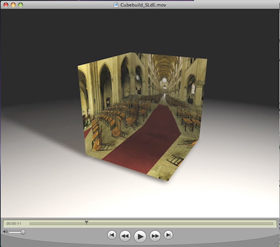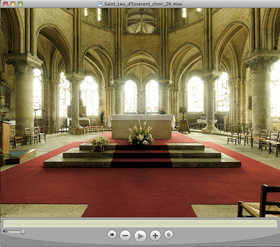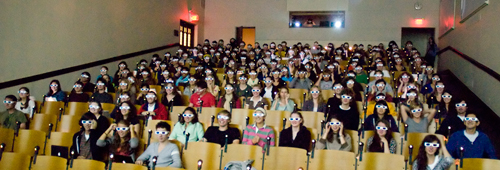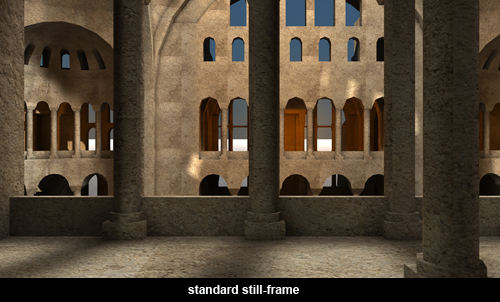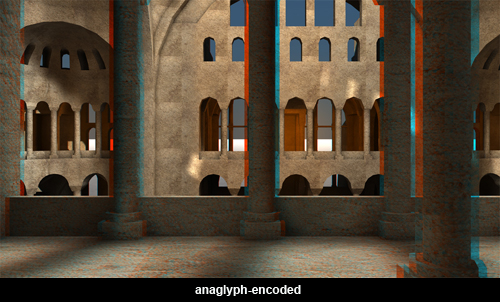ART 105, 220, 221, 320
Taught by: Andrew Tallon
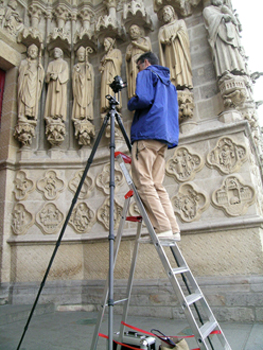 The Course
The Course
What is the course in which you use instructional technologies about? Tell us about its origin, goals and objectives.
Most of my courses deal with space—the nave space of a Gothic cathedral, the space of a chapel on whose interior surfaces narratives are written in fields of mosaic; or the funnel-like space of a great Romanesque portal. To teach spaces like these using traditional means is to employ a series of individual yet disconnected views, accompanied by a discourse which attempts to bind them back together. It can work—but it is far from ideal.
In response, I began nearly eight years ago on what I call the mission panoramique (in homage to the mission héliographique sponsored by the French Commission des Monuments Historiques in 1851), the creation of a library of now more than three thousand digital spherical panoramic photographs of great architecture throughout Europe—at present the largest such collection in existence—which allows me to take my students (and those of other institutions, with whom these photographs are shared though ArtStor) to spaces that would be otherwise inaccessible.
The Technology
How does this particular technology enhance your teaching goals?
A short film, below, will give you a sense of the way in which the virtual space of such an image is constructed; just below is the resultant spherical panoramic photograph, made in the choir of the Cluniac priory church of Saint-Leu-d’Esserent, just north of Paris. (To navigate, click on the image and hold, then move your mouse. To zoom out, hold down the control key. To zoom in, hold down the shift key.) Such images are the next best thing to being in the building itself; to teach (and learn) from an image like this is to be able to explore the material intuitively, seamlessly.
The Student Response
How have your students responded to your use of technology?
I have made extensive use of these interactive photographs, initially for teaching, and now also for both assignments and exams, in the full range of the classes I teach. In both written work and comments, students have made it clear that they were able to master and describe more complex spatial material than was possible using traditional, two-dimensional means of representation. There is also an undeniable “wow” factor: it’s fun to be able to move such an image, to have the sense that you’re exploring, that you’re really there.
The Challenges
What are the challenges you faced teaching this course?
The primary challenge was to devise paper assignments and exams that could make effective use of this medium, and to create a means of delivery that was as transparent as possible. For one of the paper assignments in my Medieval Architecture course, for example, I gave the students a series of seven spherical images from the same building hyperlinked to a ground plan; this presentation of the material, when combined with the inherent interactivity of the photograph, supplied the illusion of an unsequenced visit. Another challenge had to do with time spent preparing the media. Because I wanted to give the students access not only to the standard images and GIS maps used in class but also the spherical panoramic photos, it was necessary to build bi-weekly websites. The deployment of these various media was facilitated by the courseware environment Moodle, an alternative to Blackboard in whose Vassar pilot I was able to participate last semester.
New Directions
What new directions would you like to explore with technology in your teaching?
This past fall I introduced a new element in my lectures in Art 105: students were able to experience simulated movement through the space of the Hagia Sophia in Istanbul in virtual three dimensions thanks to computer animations produced using stereoscopic anaglyph projection technology. Below are a photograph taken during the projection in Taylor 102, and two still images from one of the films: one of them a standard still-frame and the other anaglyph-encoded (3D glasses are required to see the virtual third dimension).
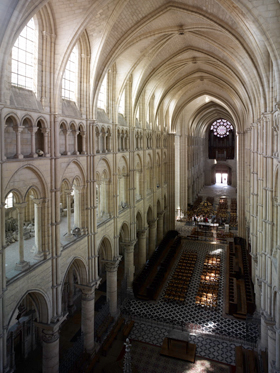 Such images are challenging to produce in cinematic form: the two 3-minute clips that I created with the 3D modeling package Cinema 4D took over 4 days to render, using three of the highest-power multiprocessor Macs on campus, working around the clock! It also took some time to master the optical geometry required to create a virtual stereoscopic image. The advantage is that the technique is directly applicable to a still camera—something I intend to explore this summer in the context of my Andrew W. Mellon Foundation-sponsored research program called Mapping Gothic France. Images such as that of Laon Cathedral, rigth, made last season with a 39-megapixel technical camera, will now be acquired in stereo, so that the experience of medieval architectural space might be better brought back to the classroom.
Such images are challenging to produce in cinematic form: the two 3-minute clips that I created with the 3D modeling package Cinema 4D took over 4 days to render, using three of the highest-power multiprocessor Macs on campus, working around the clock! It also took some time to master the optical geometry required to create a virtual stereoscopic image. The advantage is that the technique is directly applicable to a still camera—something I intend to explore this summer in the context of my Andrew W. Mellon Foundation-sponsored research program called Mapping Gothic France. Images such as that of Laon Cathedral, rigth, made last season with a 39-megapixel technical camera, will now be acquired in stereo, so that the experience of medieval architectural space might be better brought back to the classroom.
There are two related directions that I intend to explore in the near future. First, it is technically possible, though difficult, to produce anaglyph-encoded spherical panoramic photographs; I am in the process of gathering the information necessary for the required tests. And second, anaglyph stereo images are effective, but those projected using polarized light are even more so, because the full range of color of the original image is retained, and the channel separation between left and right eyes, and thus the image clarity, is far greater. With a little luck I’ll be able to secure the required projectors, polarizers and glasses to do some experiments in the fall of 2009.

